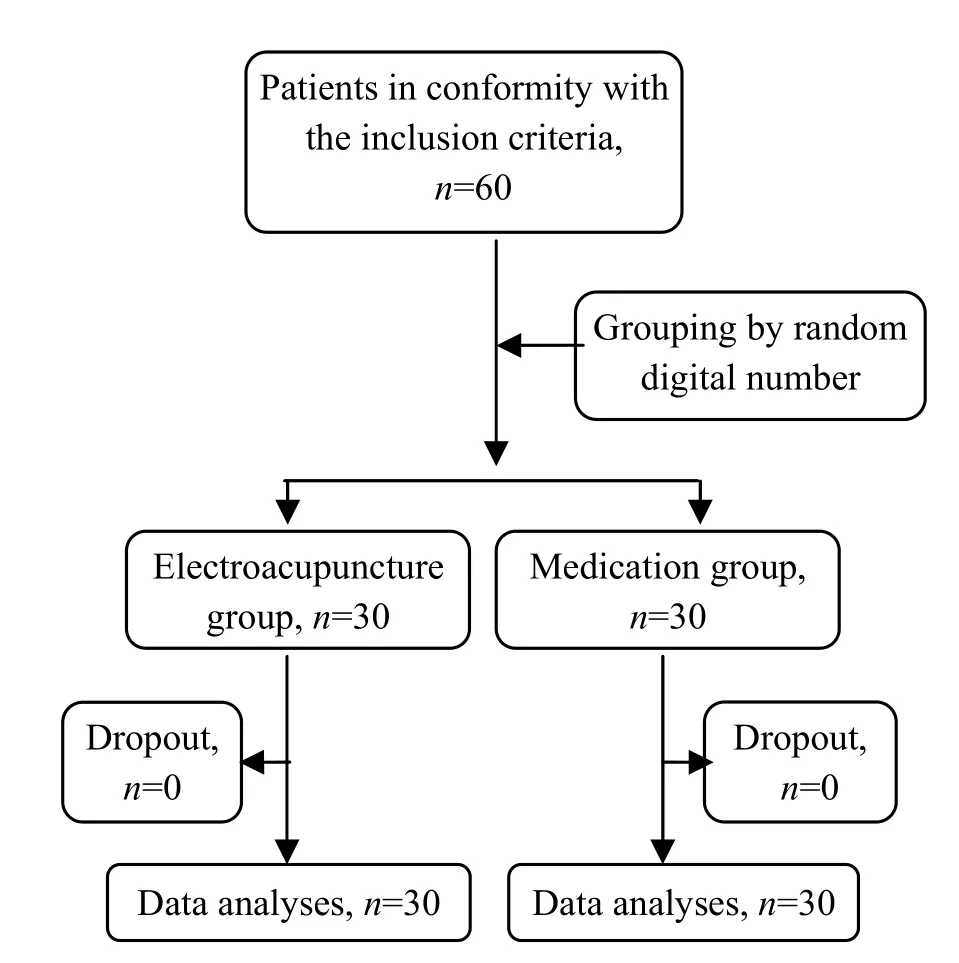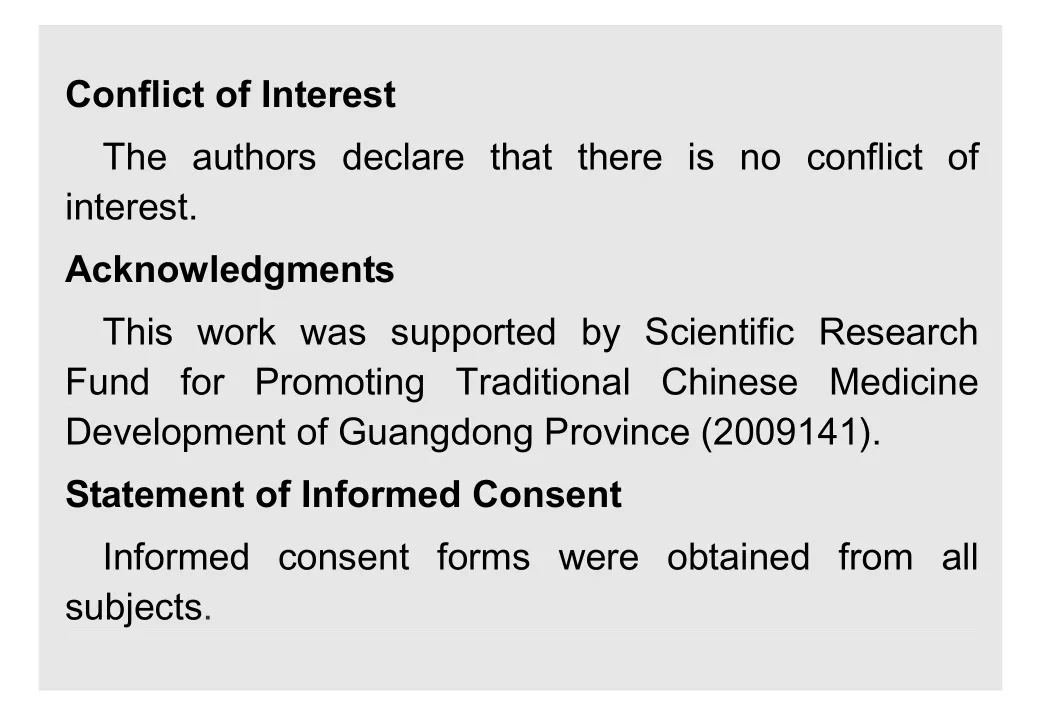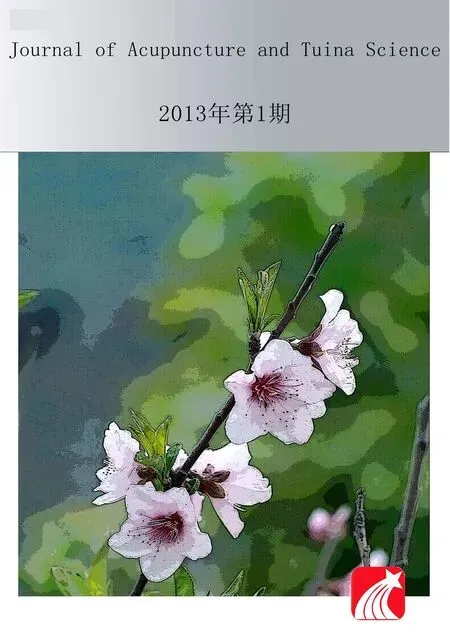Electroacupuncture in Treating Depression: A Randomized Controlled Study
Chen Xiu-ling, Xu Kai, Luo Ren-han, Lin Miao-jun
1 Fangcun Hospital of Traditional Chinese Medicine, the Third Hospital Affiliated to Guangzhou University of Traditional Chinese Medicine, Guangzhou 510360, China
2 Guangdong Second Provincial Traditional Chinese Medicine Hospital, Guangzhou 510405, China
Electroacupuncture in Treating Depression: A Randomized Controlled Study
Chen Xiu-ling1, Xu Kai2, Luo Ren-han2, Lin Miao-jun2
1 Fangcun Hospital of Traditional Chinese Medicine, the Third Hospital Affiliated to Guangzhou University of Traditional Chinese Medicine, Guangzhou 510360, China
2 Guangdong Second Provincial Traditional Chinese Medicine Hospital, Guangzhou 510405, China
Objective: To observe the clinical efficacy of electroacupuncture in treating depression.
Methods: By a randomized controlled study method, sixty patients with depression were randomized into an electroacupuncture group and a medication group, 30 in each. The electroacupuncture group was treated with electroacupuncture, and the medication group was orally administrated Paroxetine tablets. They were evaluated by using Hamilton Depression Scale (HAMD) before and after treatments and the safety was also assessed.
Results: The total effective rate was 83.3% in the electroacupuncture group versus 60.0% in the medication group, and the difference was statistically significant (P<0.05). The electroacupuncture groupwas superior to the medication group in comparing the improvement of HAMD scores after treatment (P<0.05).
Conclusion: Electroacupuncture is an effective approach in treating depression.
Acupuncture Therapy; Electroacupuncture; Depression; Randomized Controlled Trial
Depression is a mental disorder characterized by low mood and slow mental reaction, coupled with reduced and retarded words and movements[1]. Currently, depression is running an increasing incidence[2]. Both traditional and novel anti-depressive drugs may produce varying levels of adverse and side effects, addiction, and contraindications, severely affecting treatment and compliance in clinic. To display the advantages of acupuncture-moxibustion therapy as well as traditional Chinese medicine, it’s been a trend to explore a new traditional Chinese medicine method in treating depression. Electroacupuncture at Sishencong (EX-HN 1) has proved to be an effective approach for depression through clinical practice. We therefore adopted this method to treat 30 cases with depression, and compared it with another 30 cases treated with routine medication, and now report it as follows.
1 Clinical Materials
1.1 Diagnostic criteria
The severity of depression was graded by using Hamilton Depression Scale (HAMD) (24 items in total): mild depression was scored 20-26; moderate depression was scored 27-34; severe depression was scored≥35[3].
According to the standard inChina Classification and Diagnostic Criteria of Mental Disorders(3rd edition)[4], it is majorly characterized by feeling of sadness or despair, coupled with at least 4 of the following 9 items: a loss of interest in things that once were pleasurable; loss of energy or fatigue; psychomotor retardation or agitation; low esteem, self-accusation, or feeling of guilt; difficulty in association or decline in thinking ability; recurrent thoughts of death or suicide; sleep disorders, such as insomnia, waking up early, or hypersomnia; decrease in appetite, and/or obvious loss of weight; reduced sex drive.
1.2 Inclusion criteria
Conforming to the diagnostic criteria of depression; haven’t taken any antidepressants during the recent 1 week and without any other treatment from the current onset to the visit; aged 30-65 years old; have signed the informed consent form and can stick to the treatment protocol.
1.3 Exclusion criteria
Not conforming to the above diagnostic criteria or inclusion criteria; organic mental disorders, and depression, schizophrenia, neurasthenia, or bipolar affective disorder (manic depressive psychosis) due to psychoactive substances or non-addictive substances, and somatic diseases, as well as alcoholism and drug-induced reactions; with complications including cardiovascular and cerebrovascular diseases, and diseases of liver, kidney and hematopoietic system that may threaten the life; taking other drugs or therapies that will affect the treatment result.
1.4 General data
Sixty eligible subjects with depression, from the Acupuncture Department of Fangcun Hospital of Traditional Chinese Medicine, the Third Hospital Affiliated to Guangzhou University of Traditional Chinese Medicine, and the Acupuncture-rehabilitation Department of Baiyun Branch, Guangdong Second Provincial Traditional Chinese Medicine Hospital, were randomized into an electroacupuncture group and a medication group by random number table, 30 in each group.
It showed insignificant differences in comparing data of gender, age, and disease duration between the two groups (P>0.05), indicating the comparability (table 1).
The clinical treatment processes of the two groups are shown in Fig.1.
Table 1. Comparison of general data ()

Table 1. Comparison of general data ()
GroupsnGender (case) Male Female Age (year) Disease duration (year) Electroacupuncture 30 10 20 43±3 4.0±0.7 Medication 30 11 19 45±4 4.2±0.8

Fig.1 Clinical treatment process
2 Treatment Methods
2.1 Electroacupuncture group
Acupoint: Sishencong (EX-HN 1).
Operation: The patient took a sitting or supine position. After standard sterilization, acupuncture needles of 0.35 mm in diameter and 25 mm in length were punctured horizontally towards Baihui (GV 20) with an angle of 15° between needle body and scalp. The needles should be inserted swiftly, reaching to the subgaleal plane quickly. Needling manipulations of lifting-thrusting and rotating were performed afterwards, with a frequency at 150-200 times/min and equal force between forward and backward movements for obtaining a balance. When needling sensation arrived, electroacupuncture apparatus of type G6805-1 was connected, with continuous wave and intensity within patient’s tolerance. Needles were retained for 30 min. The treatment was given once a day, 4 weeks as a treatment course. One treatment course was conducted in total.
2.2 Medication group
Patients in the control group took Paroxetine (Tianjin SmithKline & French Laboratories Ltd., National Code: H10950043), 20 mg once a day, 4 weeks as a treatment course. One treatment course was conducted in total.
With appropriate explanation, persuasion, and encouragement, patients in the two groups were prohibited from using other psychotropic drugs or traditional Chinese medicine therapies for antidepression.
3 Therapeutic Efficacy
3.1 Observation indexes
3.1.1 HAMD score
The two groups were scored by using HAMD before and after treatments, covering 24 items and 76 scores in total. It was performed by a doctor from our department after professional training.
3.1.2 Safety assessment
Ever since the subject signed the informed consent form, to the end of the treatment course, any events that were against the treatment would be regarded as adverse events, no matter whether they were directly caused by the treatments adopted in the study. The adverse events should be recorded honestly in the adverse event tables of the informed consent form, including onset time, severity, lasting time, actions taken, and result. Safety grading is divided into 4 degrees: grade 1 refers to being safe and without adverse reactions; grade 2 refers to being comparatively safe, and no actions need taking to deal with the adverse reaction for continuing the study; grade 3 refers to having safety problems, and the adverse reactions are moderate and need actions to deal with for continuing study; grade 4 refers to that the study has to be terminated because of the adverse reactions.
3.2 Criteria of therapeutic efficacy[5]
Recovery: Symptoms are gone, and normal emotion is restored.
Improved: Symptoms are reduced, and emotion is substantially steady.
Failure: Symptoms and emotion status keep unimproved.
3.3 Statistical analysis
The SPSS 13.0 software was adopted for statistical analyses. Measurement data were expressed by (), and analyzed by usingt-test; comparison of rate was performed by Chi-square test.
3.4 Treatment result
3.4.1 Comparison of therapeutic efficacy
The total effective rate was 83.3% in the electroacupuncture group versus 60.0% in the medication group, and the difference between the two groups was statistically significant (P<0.05), indicating that the electroacupuncture group has higher total effective rate than the medication group (table 2).

Table 2. Comparison of therapeutic efficacy (case)
3.4.2 Comparison of HAMD scores
In comparing HAMD scores before treatments, there was no significant difference between the two groups (P>0.05), indicating the comparability. After treatments, both of the two groups gained significant changes in evaluating HAMD scores (P<0.01), revealing that the two treatment protocols both can improve the depression status of depression patients. There was significant difference between the two groups in comparing HAMD scores after treatments (P<0.05), meaning that the electroacupuncture group has better improvement in HAMD score than the medication group (table 3).
Table 3. Comparison of HAMD scores (, point)

Table 3. Comparison of HAMD scores (, point)
Note: Compared with pre-treatment result in the same group, 1)P<0.01; compared with the medication group after treatment, 2)P<0.05
Electroacupuncture30 28.17±2.17 7.47±3.951)2)Medication 30 28.10±1.18 10.30±6.191)
3.4.3 Comparison of safety evaluation
Safety evaluation was performed from the perspectives of adverse events and security grading. In the present study, no adverse events happened in the electroacupuncture group, and the subjects’ safety evaluation were all grade 1; 8 cases experienced dizziness, nausea and perspiration in varying degrees in the medication group, and their safety evaluation were grade 2 and it’s grade 1 for rest of the subjects. It demonstrates that the general technique of using electroacupuncture at points Sishencong (EX-HN 1) is safe and practical.
4 Discussion
Depression is a kind of mental or emotional disorder with depression as the major symptom due to various reasons, and is a kind of clinical syndrome or status with self-experienced depression as the center. The causes of depression are quite complicated, involving multiple factors including genetic, biochemical, and social-psychological-cultural factors[6]. Modern medicine usually treats depression with antidepressants[7]. However, when these drugs produce a certain treatment effect, they bring along significant adverse reactions, such as anticholinergic reaction, central nervous system toxicity, and adverse reactions of cardiovascular and digestive systems. These reactions have restricted the application of the drugs to elderly patients and the patients with somatic diseases. Novel antidepressant is safe and has satisfactory treatment effect, but only 60%-70% of the depression patients show response to it, not to mention that it takes long time to act. Therefore,the current antidepressants all have limitations to some extent.
Depression should belong to the scopes of depression syndrome, hysteria, lily disease, or manic in traditional Chinese medicine. In theHuang Di Nei Jing(Yellow Emperor's Classic of Internal Medicine), it mentioned for the first time that depressed emotion would lead to disease. Acupuncture-moxibustion therapy has been used to treat depression ever since the ancient time. During recent years, it’s proved that acupuncture-moxibustion is effective in treating this disorder[8-14], and has shown obvious point-selection rules[15-16]. Because depression is diseased in brain, points on head are often selected as major points. Sishencong (EX-HN 1) are our experiential points for depression. They are extra points located on top of the head and are points of yang qi. The anterior and posterior points are on the Governor Vessel, and the two lateral points are approaching the Bladder Meridian. The Governor Vessel connects with brain, and the Bladder Meridian also connects with brain after entering vertex. Consequently, needling Sishencong (EX-HN 1) works to reinforce brain and calm mind, and regulate emotion. With the assist of electroacupuncture, it can promote the establishment of the cerebrovascular compensatory circulation, improve cerebral blood flow, activate cholinergic neurons, and promote and strengthen the compensation of brain functions, and finally treat depression. The present study results show that symptoms get improved in both electroacupuncture group and medication group, but the electroacupuncture group has a more significant improvement and the acupuncture treatment is safe and practical.

[1] Li SW. Pay attention to the diagnosis of depressive disorder in integrated hospital. Zhonghua Shenjing Ke Zazhi, 2004, 37(1): 91.
[2] Lin H, Li HQ, Zhou ZB, Liu JX. Observation on therapeutic effect of combination of acupuncture with drug on depression. Zhongguo Zhenjiu, 2005, 25(1): 27-29.
[3] Zhang MY. Handbook for Psychological Evaluation. Changsha: Hu’nan Science and Technology Publisher, 2006: 122-123.
[4] Psychology Branch of Chinese Medical Association. China Classification and Diagnostic Criteria of Mental Disorders. 3rd Edition. Ji’nan: Shandong Science and Technology Publisher, 2001: 160-68.
[5] State Administration of Traditional Chinese Medicine. Criteria of Diagnosis and Therapeutic Effects of Diseases and Syndromes in Traditional Chinese Medicine. Nanjing: Nanjing University Press, 1994: 33-34.
[6] Zhang H. Cause of depression and its medication treatment. Neijiang Keji, 2007, (10): 181-183.
[7] Zhou CY. Depression and reasonable application of anti-depression medication. Liaoning Yixue Zazhi, 2007, 21(3): 214-216.
[8] Wang Y. General status of acupuncture-moxibustion treatment for depression. Shandong Zhongyi Zazhi, 2007, 26(12): 868-870.
[9] Nie B, Nie T. Clinical study on electroacupuncture treatment for post-stroke depression. J Acupunct Tuina Sci, 2010, 8(6): 336-339.
[10] Wang Y, Zhang QQ. Combined acupuncture and medication in treating depression. Shanghai Zhenjiu Zazhi, 2011, 30(6): 382-384.
[11] Mu JP, Liu L, Cheng JM, Zhou LZ, Ao JB, Wang J, Fang W, Hu J. Clinical study on electroacupuncture for post-withdrawal anxiety-depression mood in heroin addicts. J Acupunct Tuina Sci, 2009, 7(4): 203-206.
[12] Zhang GB, Yang L, Zhang Q. Observation on the therapeutic effect of acupuncture on post-stroke depression. Shanghai Zhenjiu Zazhi, 2010, 29(10): 636-637.
[13] Chen HD, Jin LQ, Lou R, Zhang LM. Effects of electroacupuncture on rat model of chronic stress-induced depression. J Acupunct Tuina Sci, 2012, 10 (1): 9-13.
[14] Zhang W, Cheng SL, Lin AJ, Xie JJ, Ye QJ, Wu QY, Zhang JY, Jin HP. Effect of combined acupuncture and medication on post-stroke depression and daily activity. Shanghai Zhenjiu Zazhi, 2011, 30(12): 823-825.
[15] Hu ZC, Wu YC, Wang NH. Clinical study on acupuncture treatment of post-stroke depression in recent ten years. J Acupunct Tuina Sci, 2011, 9(5): 324-330.
[16] Huang QF. Exploration of the clinical regularity of acupuncture-moxibustion treatment for depression. J Acupunct Tuina Sci, 2009, 7(1): 57-60.
Translator: Hong Jue
R246.6
A
Date: November 5, 2012
Author: Chen Xiu-ling, associate chief physician.
E-mail: 18602054000@163.com
 Journal of Acupuncture and Tuina Science2013年1期
Journal of Acupuncture and Tuina Science2013年1期
- Journal of Acupuncture and Tuina Science的其它文章
- Acupuncture-moxibustion Theories of Wang Shu-he
- Treatment of Tolosa-Hunt Syndrome with Acupuncture: A Case Report
- Research Progress of Acupuncture Analgesia for Labor
- Clinical Study on Puncturing Houxi (SI 3) Toward Hegu (LI 4) plus Lumbar Movement for Acute Lumbar Sprain
- Therapeutic Effect of Warm Needling Therapy Combined with Rehabilitation Therapy for Brachial Plexus Injury after Surgery
- Study on the Relation Between MRI Findings and Acupuncture Effect in Trigeminal Neuralgia Patients
